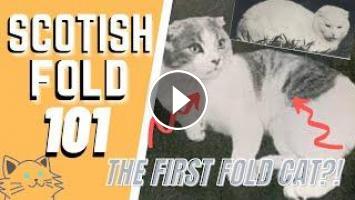Use coupon code "KITTENLIFE" to get 20% OFF #kittenlife #cat101 #scottishfold101 #catbreeds101 #scottishfold #Susiethefirstfoldcat
In today's video, we are going to talk about a cat breed that was originally discovered in a farm barn, all the way from Scotland.
The Scottish Fold.
A white farm cat named Susie was raised in 1961 at a farm near Perthshire, Scotland. She was the first and original Scottish Fold. The ears of Susie had an odd fold, making her resemble an owl. Susie then gave birth to more kittens. Amazingly Two of her kittens were born with folded ears. One of the kittens was acquired by William Ross, a nearby farmer, and cat-fancier.
Susie's only reproducing offspring was a female Fold named Sans. Sans was also white like her mother. Right after Sans was born, the second kitten was neutered shortly after birth. Sadly, Three months after Sans' birth, Susie was killed by a car. This was really a tragic event for all the people involved in maintaining the genes of the breed. Luckily she had a lot of offsprings to help her legacy survive. Up to this day, All Scottish Fold cats share a common ancestry to Susie.
Combined with their reputation as exceptionally loving companions, the uncommon distinctive physical features of the breed, make Folds highly sought-after pets. One good thing to note financially is that Scottish Fold kittens, usually cost significantly more than kittens of more common breeds. With their unique physical traits and financial value, Scottish folds became popular among celebrities. That popularity, jump-started the rise to fame of the breed.
Some common character traits of the breed are as follows.
All Folds are born with straight and/or unfolded ears. Those with the Fold gene will begin to show the fold usually within about 21 days. The kittens that do not develop folded ears are known as Straights.
The Fold's entire body structure, especially the head and face, is generally rounded, and the eyes large and circular.
The nose is short with a gentle curve. And the cat's body is well-rounded with a padded look, while having medium-to-short legs.
Short hair Scottish Folds have thick and soft fur, with long hair Folds having longer, and exceptionally dense fur around their upper thighs, toes, ears, and tail.
The Scottish Fold is a medium-sized cat, with males typically reaching 4 to 6 kg, females 3 to 4 kg.
Scottish Folds, whether with folded ears or with normal ears, are typically good-natured. They tend to adjust to other animals extremely well. They usually become very attached to their caregivers, this make's the Scottish fold's nature very affectionate. Folds are also famous for receiving high marks for playfulness, grooming, and intelligence. These animals like to be outdoors, they enjoy outdoor games, and physical activities very much. Scottish Folds heavily dislike Loneliness. This clinginess of the breed can sometimes make them feel depressed, or out of place. It is also common for Scottish Folds to be stubborn.
Folds are also known for sleeping on their backs, just like people. Scottish Folds typically have soft voices and they tend to display a complex collection of meows and purrs, almost like having their own language. Folds ideally have a distinct sitting position, with their legs stretched out, and their paws on their belly. This cute sitting position among the breed, is famously called, the Buddha Position.
The typical lifespan of a Scottish Fold is 15 years.
The most common diseases in Scottish Fold Cats.
Scottish folds are susceptible to polycystic kidney disease, and cardiomyopathy. They are also prone to degenerative joint disease, most commonly affecting the tail, ankles, and knees.
This joint illness, mostly results in a reduced range of motion of the breed.
Also, The typical lifespan of a Scottish Fold is 15 years. Making them a good long term companion.
The most common diseases in Scottish Fold Cats.
Scottish folds are susceptible to polycystic kidney disease.
PKD is an inherited disorder in which clusters of cysts develop primarily within kidneys, causing kidneys to enlarge and lose function over time.
Cardiomyopathy.
Cardiomyopathy is a Form of heart disease that is commonly seen in the breed. But it has not yet been proven to be heritable.
Degenerative joint disease.
They are also prone to degenerative joint disease, most commonly affecting the tail, ankles, and knees. This joint illness, mostly results in a reduced range of motion of the breed.
Once you know the breed's most common diseases, it is ideal that you consult your vet every now and then. Take your cat to the veterinarian at least once a year for routine check-ups. This ensures that your Scottish fold will remain healthy all throughout it's lifespan.
In today's video, we are going to talk about a cat breed that was originally discovered in a farm barn, all the way from Scotland.
The Scottish Fold.
A white farm cat named Susie was raised in 1961 at a farm near Perthshire, Scotland. She was the first and original Scottish Fold. The ears of Susie had an odd fold, making her resemble an owl. Susie then gave birth to more kittens. Amazingly Two of her kittens were born with folded ears. One of the kittens was acquired by William Ross, a nearby farmer, and cat-fancier.
Susie's only reproducing offspring was a female Fold named Sans. Sans was also white like her mother. Right after Sans was born, the second kitten was neutered shortly after birth. Sadly, Three months after Sans' birth, Susie was killed by a car. This was really a tragic event for all the people involved in maintaining the genes of the breed. Luckily she had a lot of offsprings to help her legacy survive. Up to this day, All Scottish Fold cats share a common ancestry to Susie.
Combined with their reputation as exceptionally loving companions, the uncommon distinctive physical features of the breed, make Folds highly sought-after pets. One good thing to note financially is that Scottish Fold kittens, usually cost significantly more than kittens of more common breeds. With their unique physical traits and financial value, Scottish folds became popular among celebrities. That popularity, jump-started the rise to fame of the breed.
Some common character traits of the breed are as follows.
All Folds are born with straight and/or unfolded ears. Those with the Fold gene will begin to show the fold usually within about 21 days. The kittens that do not develop folded ears are known as Straights.
The Fold's entire body structure, especially the head and face, is generally rounded, and the eyes large and circular.
The nose is short with a gentle curve. And the cat's body is well-rounded with a padded look, while having medium-to-short legs.
Short hair Scottish Folds have thick and soft fur, with long hair Folds having longer, and exceptionally dense fur around their upper thighs, toes, ears, and tail.
The Scottish Fold is a medium-sized cat, with males typically reaching 4 to 6 kg, females 3 to 4 kg.
Scottish Folds, whether with folded ears or with normal ears, are typically good-natured. They tend to adjust to other animals extremely well. They usually become very attached to their caregivers, this make's the Scottish fold's nature very affectionate. Folds are also famous for receiving high marks for playfulness, grooming, and intelligence. These animals like to be outdoors, they enjoy outdoor games, and physical activities very much. Scottish Folds heavily dislike Loneliness. This clinginess of the breed can sometimes make them feel depressed, or out of place. It is also common for Scottish Folds to be stubborn.
Folds are also known for sleeping on their backs, just like people. Scottish Folds typically have soft voices and they tend to display a complex collection of meows and purrs, almost like having their own language. Folds ideally have a distinct sitting position, with their legs stretched out, and their paws on their belly. This cute sitting position among the breed, is famously called, the Buddha Position.
The typical lifespan of a Scottish Fold is 15 years.
The most common diseases in Scottish Fold Cats.
Scottish folds are susceptible to polycystic kidney disease, and cardiomyopathy. They are also prone to degenerative joint disease, most commonly affecting the tail, ankles, and knees.
This joint illness, mostly results in a reduced range of motion of the breed.
Also, The typical lifespan of a Scottish Fold is 15 years. Making them a good long term companion.
The most common diseases in Scottish Fold Cats.
Scottish folds are susceptible to polycystic kidney disease.
PKD is an inherited disorder in which clusters of cysts develop primarily within kidneys, causing kidneys to enlarge and lose function over time.
Cardiomyopathy.
Cardiomyopathy is a Form of heart disease that is commonly seen in the breed. But it has not yet been proven to be heritable.
Degenerative joint disease.
They are also prone to degenerative joint disease, most commonly affecting the tail, ankles, and knees. This joint illness, mostly results in a reduced range of motion of the breed.
Once you know the breed's most common diseases, it is ideal that you consult your vet every now and then. Take your cat to the veterinarian at least once a year for routine check-ups. This ensures that your Scottish fold will remain healthy all throughout it's lifespan.
- Catégories
- Chats de Race Scottish Fold
- Mots-clés
- scottish fold, kitten, cat
















Commentaires